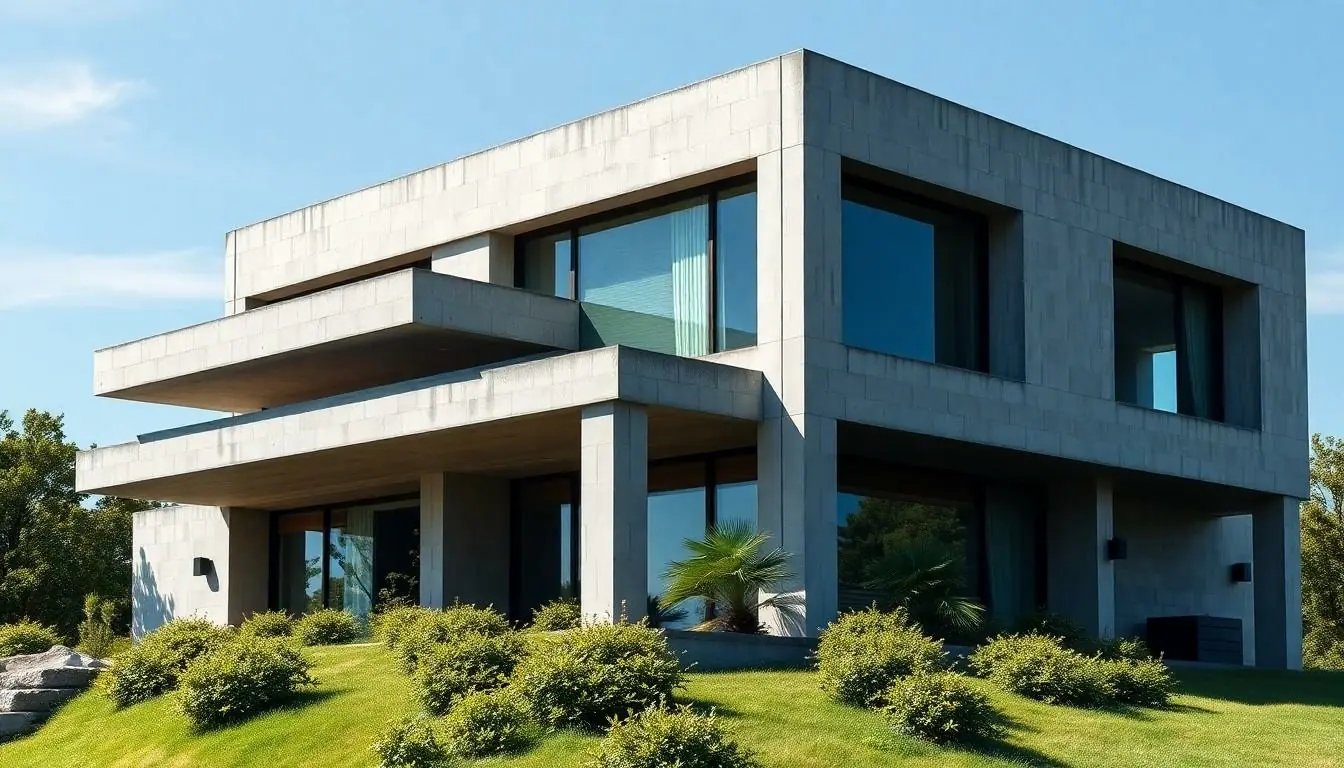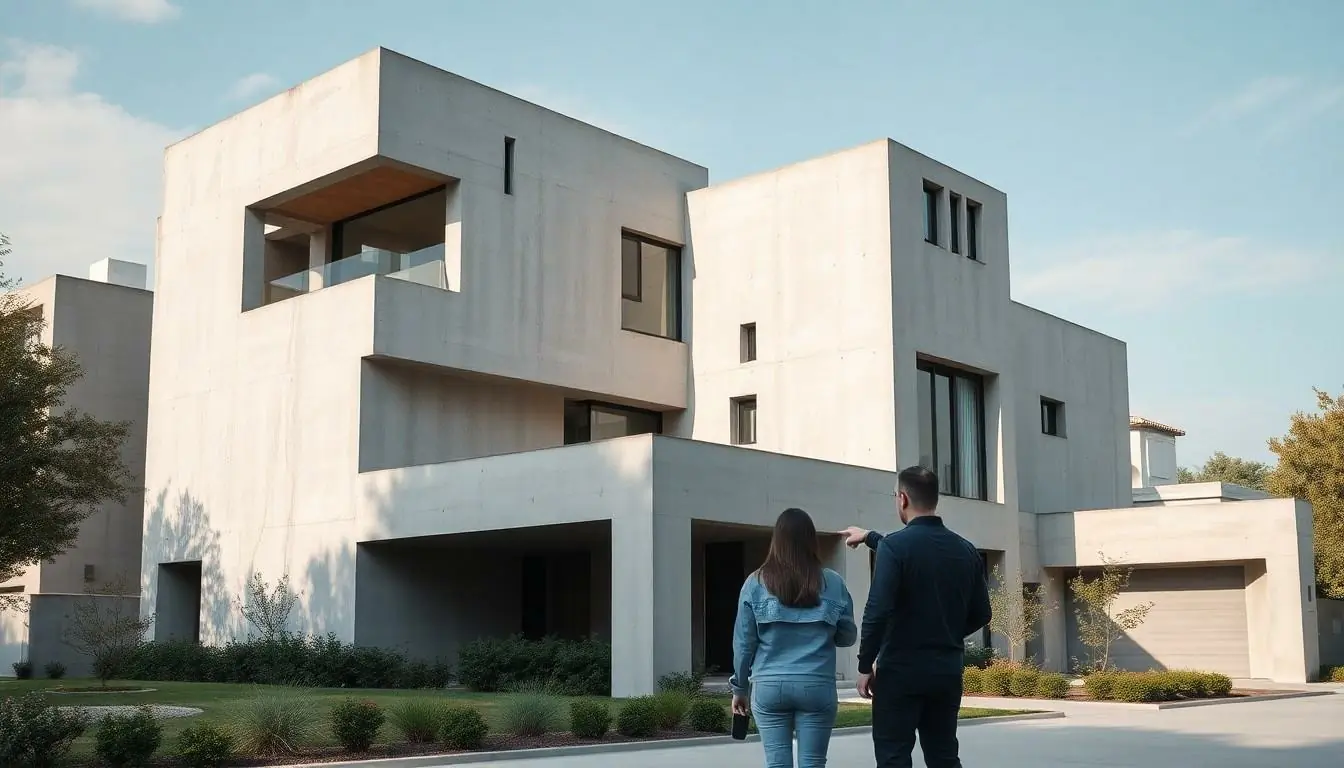Brutalist architecture houses might not be everyone’s cup of tea, but they sure pack a punch. Imagine living in a fortress that looks like it could withstand a zombie apocalypse while still being a cozy home. With their raw concrete exteriors and bold geometric shapes, these structures challenge conventional aesthetics and invite curiosity.
Table of Contents
ToggleOverview of Brutalist Architecture
Brutalist architecture emphasizes functionality and simplicity through the use of raw materials. Its signature feature, concrete, showcases a rugged aesthetic that stands in stark contrast to more traditional designs. Homeowners often appreciate the bold geometric shapes and massive forms, providing a sense of strength and permanence.
This architectural style emerged in the mid-20th century, influenced by modernism and the desire to create honest designs that reflect their materials. Structures often resemble fortresses, with thick walls and minimal decorative elements, prioritizing form over ornamentation. Such homes can be found in urban settings, where they assert their presence and create a unique skyline amid softer designs.
Sustainability plays a significant role in many brutalist houses, utilizing energy-efficient principles that reduce environmental impact. These homes often feature passive solar design and strategic ventilation, helping maintain comfortable indoor climates without excessive energy consumption. Owners frequently enjoy lower utility bills as a result of these thoughtful design choices.
Brutalist architecture invites curiosity and interpretation. The raw and unrefined appearance often prompts discussions about the beauty of imperfection. With its distinctive character, this style challenges conventional notions of beauty and invites appreciation for its unapologetic stance.
Increasingly, modern designers draw inspiration from brutalism, merging its core principles with contemporary materials and technologies. This trend enhances the relevance of brutalism in current architectural practices, connecting tradition with innovation in ways that resonate with new generations of homeowners.
Characteristics of Brutalist Architecture Houses

Brutalist architecture houses display distinct characteristics that set them apart in the architectural landscape. These homes typically emphasize durability and functionality while showcasing raw materials in their purest form.
Material Usage
Concrete serves as the primary material in brutalist homes. This choice not only accentuates strength but also defines their aesthetic. Steel and glass often complement the concrete, adding structural integrity and a modern touch. Natural stone may appear in some designs, providing warmth against the starkness of the concrete. Many homes utilize recycled materials, enhancing sustainability while promoting an eco-friendly ethos. The texture of concrete often varies, with exposed aggregate or rough finishes creating unique surface patterns that contribute to the overall character.
Design Elements
Geometric shapes dominate the design of brutalist houses. The use of bold, angular forms enhances their imposing presence. Flat roofs and cantilevered structures provide distinctive profiles against the sky. Large windows break up the mass of concrete, inviting natural light and establishing a connection with the outside environment. Minimalism defines the interior design, with open floor plans that focus on space and light. Rather than ornate decorations, these homes emphasize the beauty of simplicity, allowing the raw materials and structural elements to take center stage.
Famous Brutalist Architecture Houses
Brutalist architecture includes several iconic houses that exemplify its distinct style. Notable examples showcase how functionality merges with striking aesthetics.
The Boston City Hall
Boston City Hall stands as a prominent representation of brutalist architecture. Designed by Kenzō Tange and constructed between 1963 and 1968, this building features an imposing façade made of raw concrete. Geometric shapes dominate the structure, characterized by a bold design that elicits strong reactions. Thick walls create a sense of permanence while providing a unique visual impact. The interior spaces reflect a commitment to utility, with expansive open areas fostering a communal atmosphere. This landmark remains pivotal in urban design discussions, illustrating how brutalism can serve civic purpose while challenging architectural norms.
The Barbican Centre
The Barbican Centre resembles an architectural marvel within London’s landscape. Completed in 1982, this multi-arts venue combines residential, cultural, and recreational spaces. Featuring stark concrete exteriors, the centre embodies brutalism’s spirit with its minimal ornamentation and robust construction. The complex incorporates a mesmerizing blend of forms, emphasizing connection through its winding pathways and terraced gardens. Within, artists and audiences engage in a vibrant cultural exchange, showcasing the building’s versatility. Visitors often marvel at how the Barbican integrates art and architecture, reinforcing brutalism’s relevance in modern urban environments.
Advantages of Living in a Brutalist Architecture House
Brutalist architecture houses offer distinct advantages that appeal to those seeking a unique living experience. These homes deliver lasting benefits in terms of durability, aesthetics, and energy efficiency.
Durability and Maintenance
Concrete serves as the primary building material in brutalist homes, which contributes to their exceptional durability. Houses withstand harsh weather conditions and require minimal upkeep, making them cost-effective choices. Thick walls provide insulation against noise and temperature fluctuations, enhancing comfort year-round. Homeowners appreciate low maintenance needs, often only requiring occasional cleaning or sealing. The resilience of these structures invites families to settle in long-term without worrying about premature wear or structural issues.
Unique Aesthetic Appeal
Brutalist architecture’s striking visual style stands out in residential neighborhoods. Bold geometric shapes and raw concrete surfaces create dramatic silhouettes that catch attention. This design approach challenges conventional beauty standards and often sparks conversations. Interiors maintain a minimalist vibe, emphasizing open layouts and functional spaces that prioritize lifestyle needs. Each home reflects an artistic statement, showcasing individuality through its unique character. Owners enjoy a living environment that is both distinctive and reflective of modern design philosophies.
Criticism of Brutalist Architecture Houses
Brutalist architecture houses face criticism from various quarters. Some argue that their raw aesthetics and massive forms create an imposing presence in neighborhoods.
Common Misconceptions
Many people see brutalist structures as cold and uninviting. This perception often overlooks the intent behind the design, which emphasizes functionality and simplicity. Critics frequently regard the use of concrete as unattractive. In reality, the material demonstrates durability and versatility. Others mistakenly believe that brutalism lacks sustainability. Numerous brutalist homes actually incorporate energy-efficient principles, such as passive solar design and effective ventilation, enhancing their eco-friendliness.
Public Reception
Public reception varies widely regarding brutalist architecture. Some communities embrace its bold nature, seeing it as a statement of individuality and modernity. Conversely, others view these homes as symbols of urban decay. Transformative renovations in certain neighborhoods have revitalized public interest, reflecting a shift towards appreciating brutalist design. Urban planners increasingly recognize the importance of preserving notable examples, understanding their historical significance. The divide between admiration and disdain continues, influencing architectural discussions and urban development decisions.
Brutalist architecture houses stand as a testament to a unique blend of functionality and bold aesthetics. Their striking forms and raw materials challenge conventional design while offering durability and energy efficiency. As modern designers reinterpret these principles, brutalism continues to inspire a new generation of homeowners seeking individuality in their living spaces.
The ongoing dialogue surrounding brutalism reflects its complex nature; it’s both celebrated and critiqued. Yet, as urban environments evolve, the appreciation for these structures grows. The future of brutalist homes lies in their ability to adapt and resonate within contemporary architectural discourse, ensuring their place in the landscape of modern design.



